Save the RSR Trail
The Richmond-San Rafael Bike/Pedestrian Bridge Trail is at risk of Mon-Thurs closure by Fall 2024!
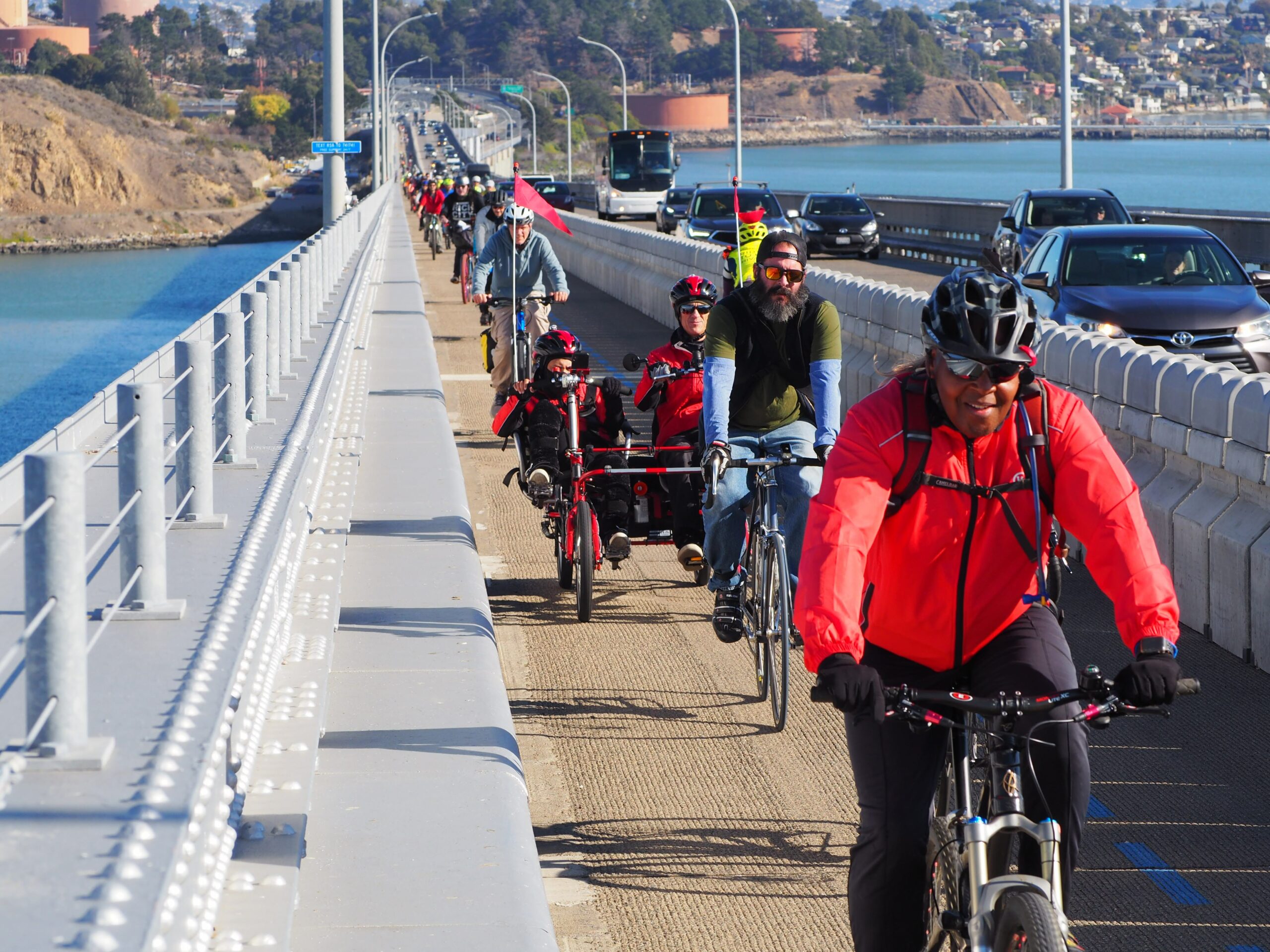
Sign the Petition: the Richmond-San Rafael Bridge is NOT just for cars.
Under MTC’s proposal, the existing movable zipper barrier would be moved back and forth on the weekends to allow bikes and pedestrians, but even this concession does not consider equitable access needed for those who must cross during the week.
MTC cannot make the decision without approval from the San Francisco Bay Conservation and Development Commission (BCDC). We will continue to organize ahead of their meeting: sign the petition to tell BCDC to maintain bike/walk access on the RSR Trail 7 days a week, 24 hours a day.
Over 2,000 people have signed our petition, and 70+ organizations have signed a coalition letter in support keeping the Richmond-San Rafael Bridge accessible.



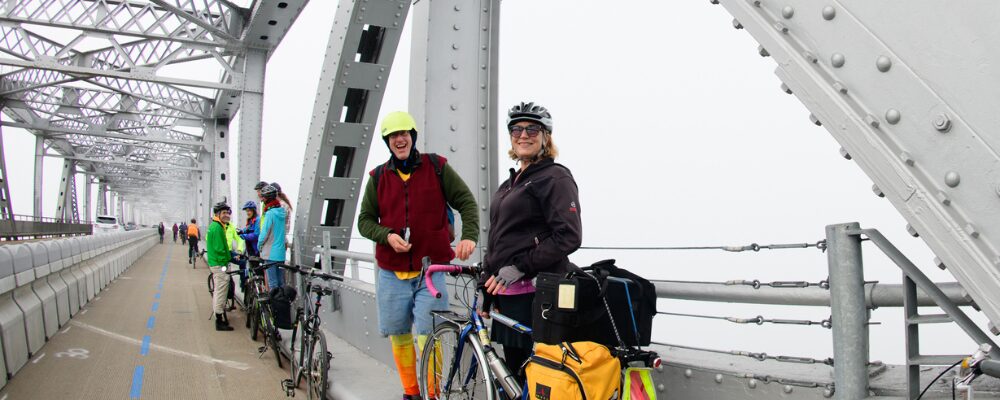
The RSR projects falls under our “Bridging the Bay” campaign. We have a dedicated listserv where we share time-sensitive alerts and project updates of our efforts to enhance connectivity between East Bay communities that have long been bisected by infrastructure barriers.

Spread the Word
Help us share out the petition and put public pressure on MTC and BCDC. We want to demonstrate that the RSR Bridge Path is a crucial access point for many!
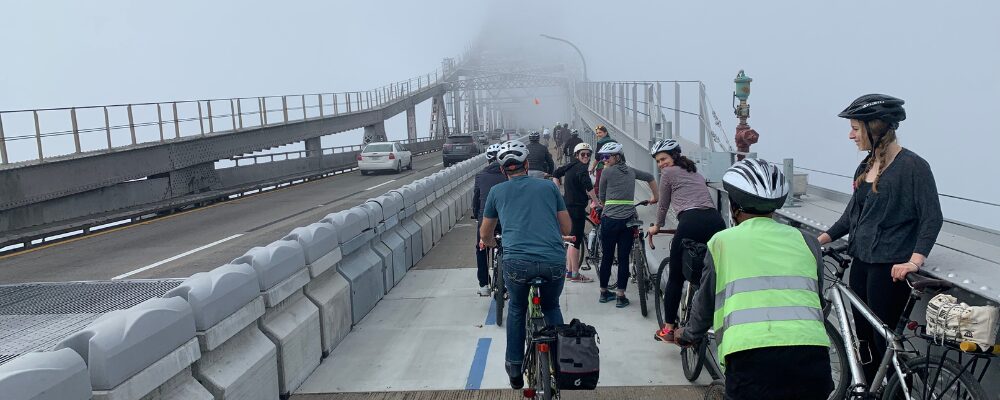
Bike East Bay fought for this path for decades, and we’re not backing down now. Donate today to ensure the Richmond-San Rafael Bridge bike path stays open seven days a week.

Frequently Asked Questions
Thanks to our friends at the Marin County Bicycle Coalition for curating this information. Visit their website for all the great work they are doing in the North Bay!
No! In the Fall of 2019, after decades of advocacy from activists on both sides of the Bay, the people path on the Richmond-San Rafael Bridge opened to great fanfare, as part of a four-year pilot project. Since then, over 300,000 people have crossed by bike or on foot.
The Bay Area Council, a regional business group with roles in the creation of BART and the Bay Conservation and Development Commission, has taken it upon itself to advocate for a third westbound car lane on the bridge. Via a front group called the “Commonsense Transportation Coalition” they sent mailers to residents of Richmond and paid for ads on Facebook and YouTube.
Their website makes inaccurate statements about the pathway, including a misleading claim that “The third lane of the westbound deck of the Richmond-San Rafael Bridge was closed to cars to provide for a pedestrian and bike lane along the bridge.” Before it became home to the bike path, the “third lane” on the upper deck had been a shoulder/breakdown area since the 1970s and not a travel lane.
Their campaign launched in 2021 and initially advocated closing off bike/pedestrian access until 11 a.m. every weekday. To their credit, they have since moderated this position by suggesting that a second moveable barrier be added to the bottom deck to maintain bike access. However this proposal also has problems.
Morning traffic headed from Richmond to Marin is bad, there’s no disagreement about that. The question is, “Would a third lane fix it?”. The answer is complicated.
Moving the pathway barrier to the side to make a third lane on the bridge won’t solve anything, because there are only two “receiving lanes” on I-580 near San Quentin, meaning the traffic jam would just move from the approach to the bridge to the bridge itself. A 2021 study from the Transportation Authority of Marin (TAM) found that I-580 would have to be widened to see congestion reduction benefits, costing $70-90 Million. But while this would shorten trips for travelers headed north on US-101, these changes would increase commute times for those headed south. To reduce congestion in both directions, an additional $250 Million dollars would be needed for a new freeway ramp.
But that would still not solve traffic problems, as decades of failed promises from freeway widenings across California and the US have proven. When we widen roads for cars, the congestion relief persists for only a short period before returning. This is because people change their behavior in response to changed conditions.
Commuters who once drove to work early to beat traffic start coming to the office later. Folks who might have passed up a job in Marin due to the long commute time decide to take it instead. Others move further away into sprawl developments enabled by the initially faster drive times. This phenomenon is called “induced travel” and it’s why the five-year, billion-dollar project to widen I-405 in Los Angeles saw traffic return worse than before within just a few years after completion.
Lastly, it is also unknown if adding more cars to the upper bridge deck, and another four-mile concrete barrier for a pathway on the lower deck, is feasible from a structural standpoint. With larger trucks and SUVs more prevalent on our roadways, and EV batteries adding additional weight, a 6-lane bridge would be under more stress than ever before. None of the recent reports evaluated the degree of strengthening to the bridge that a third lane would require, but we understand that Caltrans is studying it now.
This summer several local news reports repeated a concern that the pathway was causing pollution in Richmond. The Bay Area Council stated that “Traffic congestion caused by backup on the Richmond-San Rafael bridge is now the number one source of non-wildfire air pollution in the City of Richmond,” implying that adding a third westbound lane would change that.
When we asked them for their source they pointed us to this December 2022 report from PSE Healthy Energy. We reached out to the report’s authors to ask if the claim was supported by their study, and they responded that no, the study did not come to this conclusion.
Air quality is indeed a huge and longstanding issue in Richmond due to the presence of the Chevron refinery and multiple freeways. Residents of Richmond suffer higher rates of asthma, heart disease, and low birth weight than state averages due to poor air quality.
The 2022 PSE study acknowledged these harms but didn’t indicate that the solution to harmful emissions from a freeway is “more cars,” which a third lane would inevitably lead to. The report authors lay out several air quality mitigation measures including electrifying truck fleets, increasing transit service, and planting trees. Notably absent from their list of mitigations is adding a third lane on the bridge.
In the summer of 2022, Caltrans published an interim report on the pathway pilot (link here – warning large PDF). After the installation of the pathway, vehicle flow on the bridge decreased slightly during the peak period. Likely due to the shorter merge following the toll plaza, about 2.5 cars/minute, fewer can use the bridge.
Additionally, maximum speeds on the bridge are slightly lower than before, possibly due to the visual effect of a narrower driving space. As an unintended benefit of this, severe injury collisions are down significantly on the upper deck at a time when such severe collisions increased on the three-lane lower deck.
On the question of delay, Caltrans found that “Travel times to access the bridge from I-80 remain close to historical averages on weekdays, Saturdays, and Sundays,” and that reduced speeds on the bridge have only increased travel times “by less than one minute” compared to before the path’s installation.
This report used data through July 2022. A final report will be released in the summer of 2024 and will update these findings.
While Richmond has done a truly remarkable job since 2019 of providing protected bikeway approaches from BART, the Richmond Greenway, and the Bay Trail, Marin has not done its part. Users are left deciding between a dangerous ride on East Sir Francis Drake past San Quentin or vying with heavy truck traffic on Andersen Drive.
These gaps in infrastructure limit the use of the bridge path. We know that most people will only choose to ride bicycles for transportation if they feel safe from motor vehicle traffic. The current conditions work only for the most brave and enthusiastic riders but fail everyone else.
Happily, there are projects in the works. A half-mile bike/walk path gap on Francisco Boulevard East is supposed to be fixed starting this year. And a plan to extend the Bay Trail past San Quentin to the intersection of East Sir Francis Drake and Andersen Drive is in the early stages.
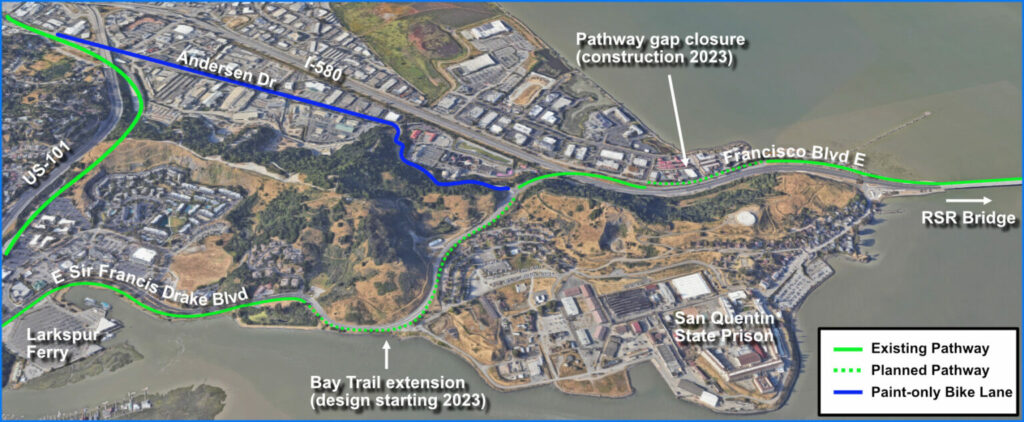
Advocates for another lane on the bridge propose spending a huge amount of money on it, up to a third of a Billion dollars! What, we wonder, could be done with that money instead of another lane that will inevitably fill up. This could warrant its own blog post, but some ideas are:
- More frequent transit – This could include a new Richmond-North Bay ferry, and bus service on the bridge with the third lane possibly used as transit-only during peak hours
- E-bike subsidies – Expanding on the existing $500-1000 rebates currently being offered (sign up today!) to Richmond-San Rafael Bridge commuters
- E-bike share on both sides of the the bridge – Allowing multimodal transit/bike commutes
- Peak-hour tolling/congestion pricing, to smooth out demand
- Workforce housing development in the North Bay – Increasing affordability and reducing the need for more transbay commute trips altogether
Fundamentally, the commute problem is a land use problem. A generation ago, just over half of Marin’s workforce lived outside of the county. Today that share is two-thirds. Many service sector, healthcare, and school employees cannot afford to live in Marin, and instead must endure hours-long trips to work. If we truly care about the people forced to make increasingly more difficult commutes to their jobs in Marin, the best solution is offer them an affordable home closer to work.
Equity & Access
Mobility justice is a vision that centers our right to exist and move freely, safely and joyfully throughout our communities. It acknowledges that people’s identities and lived experiences shape how we move through streets, and seeks to address systemic inequities.
As bicycle advocates, we must recognize and account for the ways that closing down the Richmond-San Rafael Bridge path will disproportionately affect people who ride their bicycles out of transportation necessity, not just recreation. For many, lack of access to a personal car and limited public transit options across the bridge present real challenges.
We encourage MTC and other decision-makers to think long-term about how we can create infrastructure that centers people first, not cars.

More Information
We joined Marin County Bicycle Coalition in June 2024 to answer your questions and share ways to get involved with the campaign. Check out the recording to catch up to speed.
Important Updates - Timeline
The West Contra Costa Transportation Commission (WCCTC) unanimously votes to sign a resolution to recommended continuation of the Richmond-San Rafael bridge trail pilot until after the completion of the westbound i-580 open road tolling and HOV lane project.
The City of Albany unanimously supports a resolution in support of keeping the path. “NOW, THEREFORE, BE IT RESOLVED that the City Council of the City of Albany does hereby support 24 hours a day, 7 days a week access to the Richmond-San Rafael Bridge Trail for pedestrians and bicyclists.”
Frustrating news: MTC requested and received initial authorization from BATA (Bay Area Toll Authority) to advance their plans for eliminating access of the RSR Trail. While this isn’t a final approval, it’s a significant step backwards. Help us keep the momentum by signing the petition!
A resolution of the council of the City of Richmond, California, affirming Richmond’s support for the Richmond-San Rafael bridge trail is signed with unanimous support.
Bay Trail Board of Directors signs resolution: “NOW, THEREFORE, BE RESOLVED that the San Francisco Bay Trail Project Board of Directors opposes closure of the multi-use Richmond-San Rafael Bridge Trail and authorizes each member of the Board to employ this resolution in advocating for keeping the RSR Bridge Trail open.”
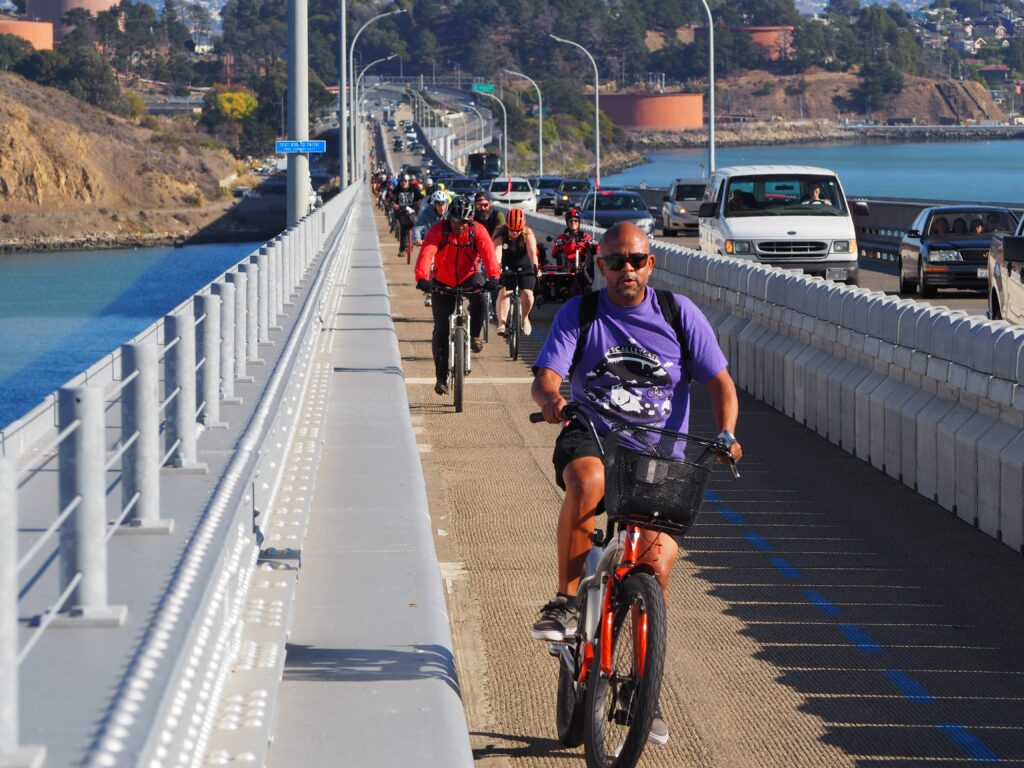
Further Reading
June 26, 2024: Cyclists commuting across bridge to Marin may need to find alternative four days a week (Richmondside)
June 6, 2024: Richmond-San Rafael Bridge – Is the Pathway Coming to an End? (Marin County Bicycle Coalition )
May 23, 2024: Call to Action: Next Step to Save the Richmond-San Rafael Bridge Bike Lane (Streetsblog)
May 16, 2024: Richmond cyclists celebrate 30 years of Bike to Work Day (Grandview Independent)
April 26, 2024: Who Rides on the Richmond-San Rafael Bridge, Anyway? (Marin County Bicycle Coalition)
March 18, 2024: Richmond-San Rafael Bridge pedestrian lane may soon be removed after four-year pilot (East Bay Times)
January 9, 2024 Richmond Bridge Bike Path Has an Amazing View — and an Uncertain Future (KQED)

